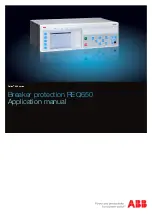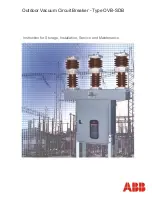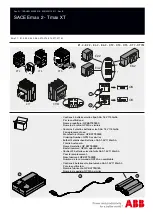
the generator nominal voltage and nominal current. The impedances from the
position of the out-of-step protection in the direction of the normal load flow can
be taken as forward.
The out-of-step relay, as in Figure
looks into the system and the impedances in
that direction are forward impedances:
•
ForwardX
= Xtr + Xline + Xeq (All values referred to generator voltage)
•
ForwardR
= Rtr + Rline + Req (All values referred to generator voltage)
The impedances that can be measured in the reverse direction are:
•
ReverseX
= Xd' (Generator transient reactance suitable for this protection)
•
ReverseR
= Rg (Relatively very small, can often be neglected)
Resistances are much smaller than reactances, but in general can not be neglected.
The ratio (
ForwardX
+
ReverseX
) / (
ForwardR
+
ReverseR
) determines the
inclination of the Z-line, connecting the point SE (Sending End) and RE
(Receiving End), and is typically approximately 85 degrees. While the length of the
Z-line depends on the values of
ForwardX
,
ReverseX
,
ForwardR
, and
ReverseR
,
the width of the lens is a function of the setting
StartAngle
.The lens is broader for
smaller values of the
StartAngle
, and becomes a circle for
StartAngle
= 90 degrees.
When the complex impedance Z(R, X) enters the lens, pole slipping is imminent,
and a start signal is issued. The angle recommended to form the lens is 110 or 120
degrees, because it is this rotor (power) angle where problems with dynamic
stability usually begin. Rotor (power) angle 120 degrees is sometimes called “the
angle of no return” because if this angle is reached under generator power swings,
the generator is most likely to lose step.
6.4.7.2
Detecting an out-of-step condition
GUID-5BBAE253-3D01-4C97-A7CF-A12084FD1810 v4
An out-of-step condition is characterized by periodic changes of the rotor angle,
that leads to a wild flow of the synchronizing power; so there are also periodic
changes of rotational speed, currents and voltages. When displayed in the complex
impedance plane, these changes are characterized by a cyclic change in the
complex load impedance Z(R, X) as measured at the terminals of the generator, or
at the location of the instrument transformers of a power line connecting two power
sub-systems. This was shown in
. When a synchronous machine is out-of-
step, pole-slips occur. To recognize a pole-slip, the complex impedance Z(R,X)
must traverse the lens from right to left in case of a generator and in the opposite
direction in case of a motor. Another requirement is that the travel across the lens
takes no less than a specific minimum traverse time, typically 40...60 milliseconds.
The above timing is used to discriminate a fault from an out-of-step condition. In
, some important points on the trajectory of Z(R, X) are designated. Point
0: the pre-fault, normal load Z(R, X). Point 1: impedance Z under a three-phase
fault with low fault resistance: Z lies practically on, or very near, the Z-line.
Transition of the measured Z from point 0 to point 1 takes app. 20 ms, due to
Fourier filters. Point 2: Z immediately after the fault has been cleared. Transition of
1MRK 506 382-UEN A
Section 6
Impedance protection
Line distance protection REL650 2.2 IEC
143
Technical manual
Summary of Contents for RELION 650 SERIES
Page 1: ...RELION 650 SERIES Line distance protection REL650 Version 2 2 Technical manual ...
Page 2: ......
Page 46: ...40 ...
Page 56: ...50 ...
Page 164: ...158 ...
Page 264: ...258 ...
Page 304: ...298 ...
Page 320: ...314 ...
Page 338: ...332 ...
Page 438: ...432 ...
Page 468: ...462 ...
Page 534: ...528 ...
Page 646: ...640 ...
Page 660: ...654 ...
Page 676: ...670 ...
Page 800: ...794 ...
Page 836: ...830 ...
Page 890: ...884 ...
Page 894: ...888 ...
Page 940: ...934 ...
Page 941: ...935 ...
















































